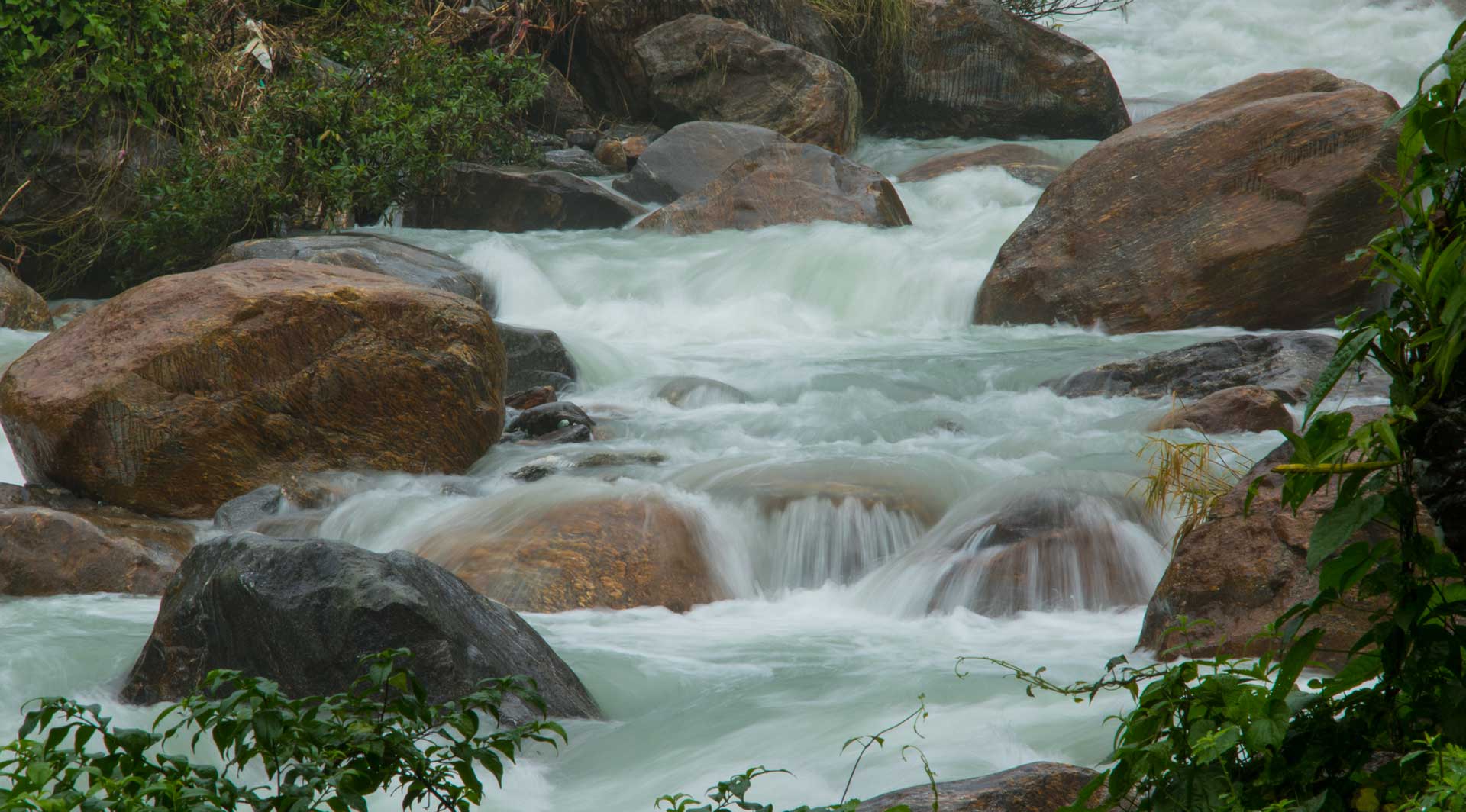
Located on the banks of the Jaldhaka River, this small village is another underexplored jewel of the Dooars Himalayan foothills. What Jhalong lacks in flashy tourism infrastructure, it makes up for in soulful landscapes, cultural fusion, and sheer serenity.
Jhalong is spread over two primary roads. The lower road runs along the Jhalong–Bindu route, hugging the riverbank and hosting the busy market square. A second road climbs briefly above the bazaar before stretching eastwards, parallel to the river, and is where most of the older residential buildings stand. These houses were built during the construction of the Jaldhaka Hydroelectric Project in the 1960s and 70s.
Just across the Jaldhaka River lies Phase 2, a Bhutan-facing village named after the second phase of the power project. With fewer than 100 homes, Jhalong remains a small, close-knit community, where farming, river-fishing, and border trade are still the main ways of life.
Reaching Jhalong is half the experience. Whether you're coming from Siliguri, NJP, or Malbazar, the last leg of your journey will take you through elephant corridors, dense sal forests, and snaking mountain roads with Jaldhaka glinting in the distance.
From NJP or Bagdogra Airport (approx. 100 km): The drive takes around 2.5 to 3 hours. Take NH-17 toward Dooars and divert at Khunia More, which is about 10 minutes from Chalsa or Nagrakata.
From Khunia More: Head north through Chapramari Wildlife Sanctuary—a 12 km stretch of road where elephants and Indian gaurs are often spotted, especially in the early mornings or just before dusk. After reaching Kumani, turn right and drive another 5 km to Naxal Bridge, where the river finally reveals itself, flanked by forest on one side and Bhutan on the other. From there, it’s another 6 km to Jhalong Bazaar.
Rail Connectivity: Chalsa and Nagrakata are the closest stations, although most long-distance trains don’t stop here. For better connections, use NJP or Malbazar.
Pro tip: Be mindful of the local check post near Jhalong. All outside vehicles are logged. If you're hiring a car, ensure all documents are valid, as unregistered taxis often get flagged.
For hassle-free transfers and forest drives, call NBTT Travel Solution Pvt Ltd at 9733300696. We arrange experienced drivers, compliant vehicles, and custom pick-ups from anywhere in North Bengal.
Jhalong isn’t built for mass tourism—and that’s precisely its edge. There are no flashy cafes or souvenir shops. Instead, you’ll find long walks through orchid-laced trails, riverside picnics, tea with villagers, and postcard-worthy sunrises.
Located about 10 km north of Jhalong, this hydroelectric dam is one of the oldest in the region (completed in 1967). While the project itself has seen better days, the dam site at Bindu has become a magnet for tourists, offering views of Bhutan’s mountains, gushing river currents, and lazy waterbirds.
Just 20 minutes from Jhalong, Dalgaon Viewpoint opens up sweeping views of the surrounding hills and the Bhutan valley. Gairibas, even closer, offers sublime perspectives of the Jaldhaka River winding through forested ridges. These are local favourites for photographers and picnic-goers.
Tungsung – Just 8 km uphill, this tranquil farming village will charm anyone with a love for slow life and scenic walks.
Today and Tangta – 20 km from Jhalong, these twin villages used to be major cardamom producers. Today, they’re untouched gems offering dramatic Himalayan landscapes and are among the least visited places in Bengal.
The large water reservoir and dense mixed forests around Jhalong attract both resident and migratory birds. Among the rare sightings recorded here: Rufous-necked Laughingthrush, Brown Dipper, Hodgson’s Redstart, Slaty-backed Forktail, Eurasian Wryneck, and Crested Kingfisher. Bird lovers are advised to bring their binoculars and visit early morning.
Jhalong has also evolved into a popular day-trip destination for tourists based in Gorumara. From Lataguri, the drive is about 50 km and takes around 2 hours. Most of our Gorumara packages now include a full-day tour of the Jhalong–Bindu–Paren–Rongo circuit.
Jhalong does not offer five-star hotels or luxury suites, but what you will find is soulful hospitality, scenic balconies, home-cooked meals, and a deep sense of connection with the land.
Humro Home Homestays are available across Paren, Jhalong, and Bindu. These are well-curated eco-resorts and family-run accommodations that blend modern comfort with natural surroundings. Whether you're looking for riverside views or forest-facing cottages, we’ll help you choose the right one.
Managed by the West Bengal Forest Development Corporation, this is a popular choice for forest lovers. As of 2022, the property includes a few AC and non-AC cottages right beside the river. The ambience is magical— especially at dawn or after rain—but this is a raw nature stay. Expect average service, basic food, and lots of insects at night. If you love wilderness, you’ll love it. If you prefer polished urban comfort, consider staying in Paren or Rongo instead. Keep a watch on the tall trees around, you are highly likely to see some exotic birds, including the Hornbill.
For booking accommodations across Jhalong, Bindu, or Paren, contact NBTT Travel Solution Pvt Ltd at 9733300696. We’ll recommend the best homestay, lodge, or eco-resort based on your budget, travel dates, and comfort preferences.
Jhalong is best enjoyed between October and April when the skies are clear, the river is calm, and the air is fresh with wildflowers and bird calls. The monsoon months (June–September) bring verdant beauty and misty charm, but also frequent landslides and slippery roads, so travel with caution during this time.
Winter (December–February) is especially picturesque, with misty mornings and chilly evenings. Great for stargazing, hot thukpa, and riverside bonfires.
Siliguri Office - 19 MN Sarkar Road, Siliguri, West Bengal - 734001 Siliguri, State : West Bengal, Country : India. PIN : 734001
info@north-bengal.com